Before the Kitchen: ALT Eating
Top Photo: santamaさん on PhotoAC
When you first come to Japan as a Borderlink ALT, you may spend the first several weeks in a hotel. And when you move into your apartment, you might not have immediate access to kitchen appliances such as a fridge, microwave or stove – it might take days or a week for them to arrive. In this buffer period before you have a proper kitchen, how should you approach the question of food?
If money isn’t an issue for you, you can always eat out. Even if you like to live frugally (like I do), I’d encourage treating yourself at a restaurant every so often. Look for somewhere you’ve never been to and explore. Or, find a place you like with low prices and explore their menu every time you come.
Restaurants
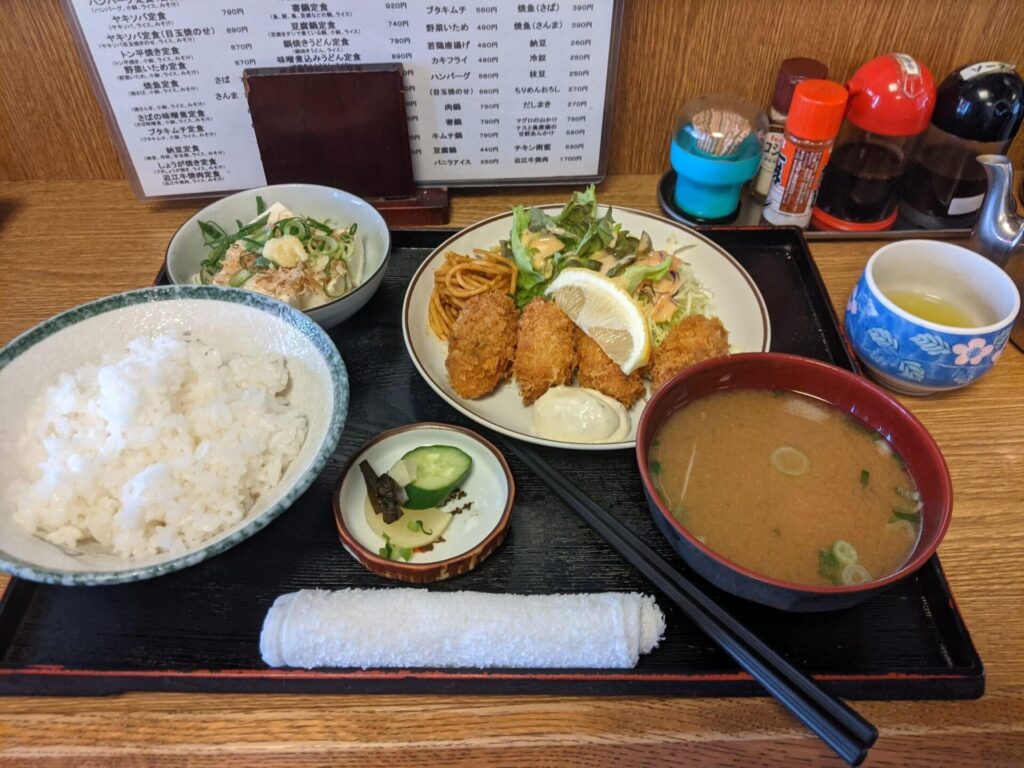
I really recommend places that offer teishoku (定食), or set meals. These meals include rice, soup and all sorts of vegetable-based sides for you to discover alongside the main meal. Take your time enjoying the soup – it heals your soul after the often frenetic move-in. Pictured is kaki fry (カキフライ), fried oysters. This dish has a nice crunchiness and a soft interior. I learned how much I loved this dish shortly after landing in Japan.
However, at the time of writing, we live in a time of coronavirus. Depending on the country you’re coming from, you might not be able to enter restaurants yet due to quarantine. And of course, I wouldn’t advise burning a hole in your wallet by eating at a restaurant every day. One other, cheaper choice would be a…
Konbini
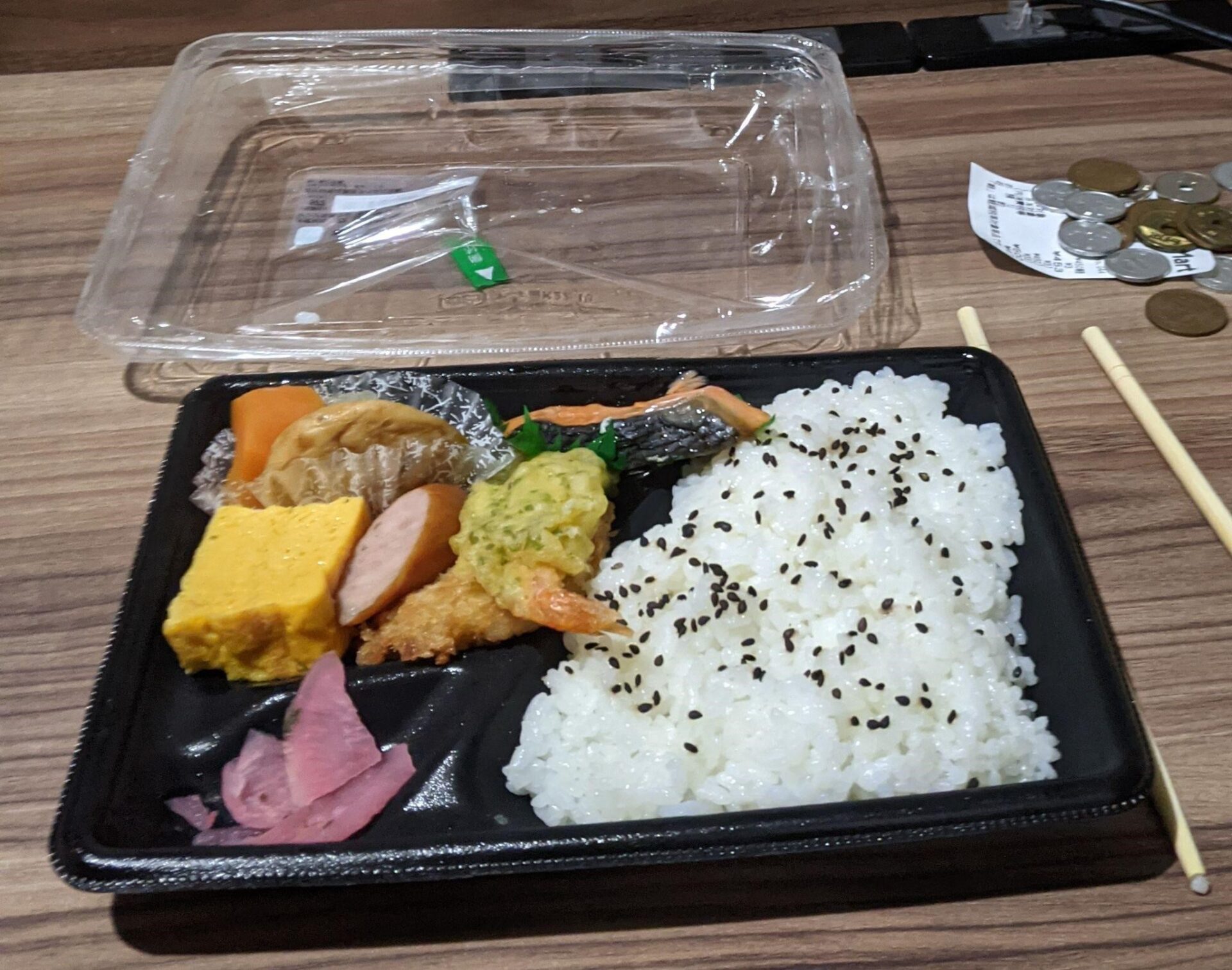
Japan’s well-known konbini, or convenience stores. These konbini offer anything you might need at a moment’s notice. They’re most famous for having a great variety of delicious meals, from complete bentos like the one pictured, to onigiri, fried chicken, sushi, etc. One meal that I have to recommend is the egg sandwich. I bought it once in a set of two sandwiches – cutlet sandwich and egg sandwich – and the impeccably fluffy egg sandwich was my unexpected favorite.
If you’re in the mood to eat out but you don’t want to burn cash at a restaurant, head to a konbini. You can even dine in, since many offer tables with outlets for your phone or laptop. Depending on your level of Japanese, you can read the magazines that are available at any konbini, too.
But, I’ll be honest with you. I don’t go to the konbini for food nearly as much as most foreigners do. That’s because I have the good fortune of living right next to a…
Grocery Stores
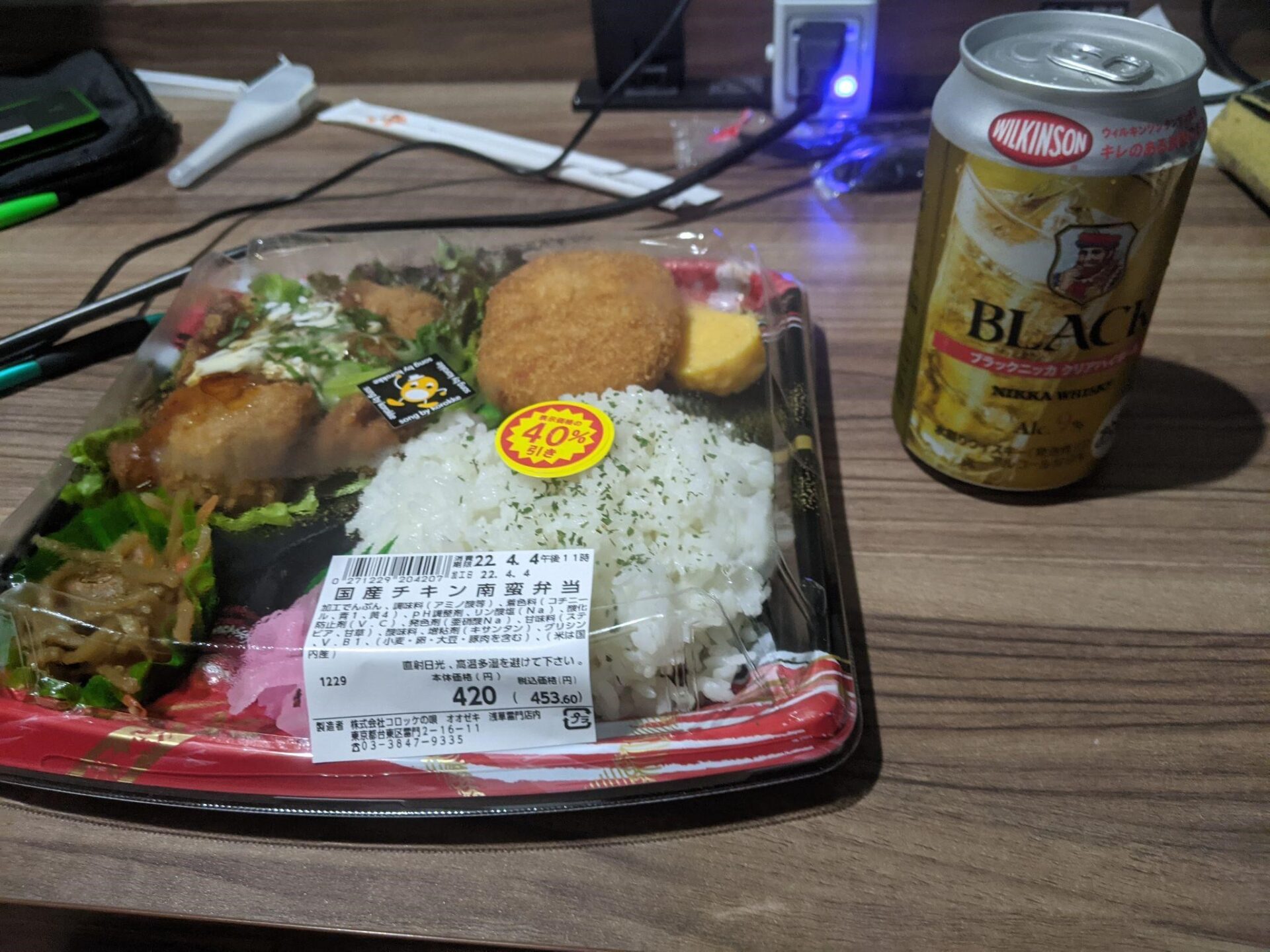
This is the cheapest choice for premade meals. Grocery stores offer not only complete meals but components of meals, like main dishes, salads and plain cooked rice for you to mix and match. The selection varies significantly from store to store, so feel free to explore.
In the day, the prices are slightly lower but comparable to convenience stores. However, at a certain time of night, either around 7 PM or two hours before the grocery stores close, discounts will be placed on them to encourage people to buy. And many people swoop in at exactly that time of night to do so! If you arrive too late, you might find the premade meal section empty.
You can find discounts for anywhere from 20% off or even as much as 80% off (it depends on the store). One word to keep an eye out for is hangaku (半額): half price.
Enjoy, and good eating!
Photo Credits:
Top Photo: santamaさん on PhotoAC
All additional images taken and provided by Mark Fretheim, used with permission.
All other content (text) created by the original author and © 2022 MUSUBI by Borderlink
Top Photo: cheetahさん on PhotoAC
What do we think of when we think of Japanese cuisine? Healthy? Sure. Sushi? Yup. Ramen. Undoubtedly. Izakaya? Uh-huh. But perhaps in an overarching way, the best answer might be….fish. Being an island country, obviously fish has always been a major part of Japan’s diet. However, not only for this reason has it been such an integral part of the food culture here.
Until around when Japan opened its borders in 1845 and foreign culture and cuisine suddenly rushed in, Japan’s mindset about meat was basically taboo. There was some culture of hunting bear and deer (as there still is today) in the mountainous regions, but those people were generally thought of as uncultured rural folk. Meat was forbidden to eat by Buddhist doctrine, and was widely considered “dirty”.
Therefore, most Japanese people had to get their protein in other forms: soy, a variety of beans, sometimes insects (also in rural areas), and….you guessed it! Fish! Fish is so much upheld as a staple of everyday life and an ingrained part of the culture that there are several special events surrounding certain types ‘o fish. Today I will introduce a couple that I know and love.
Meguro Sanma Festival
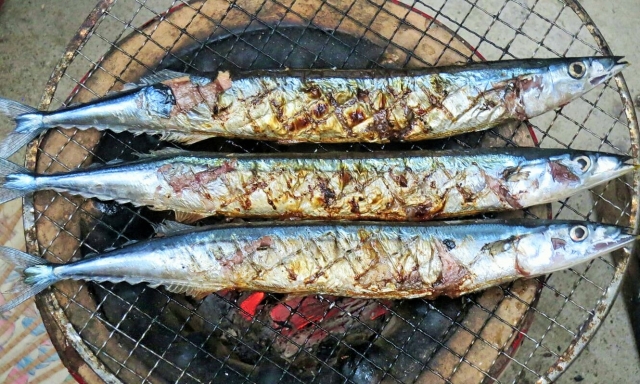
Sanma, or saury (yes, I also didn’t know that one…) are a type of smaller fish, akin to sardines, a “blue fish”, are prolific in Japan. Cooked in a variety of ways, they have their own special festival which takes place in Meguro. Every year (pandemic restrictions not withstanding) in early September, the town association gives away, FOR FREE, around 7000 grilled sanma!
In a very lively and festive atmosphere, with stall also selling a variety of other foods and drinks, you can line up (for quite some time) to get your own grilled sanma. Started in 1996, the story of the origin of the festival is much older. As it goes, a hungry nobleman decided to get something to eat while in the Meguro area and decided to try some grilled sanma, despite it being considered a cheap peasant street food (as was sushi, in fact!), and he loved it!
Being that it wasn’t something that he could have regularly at his palace, it being peasant food and all, he was said to return to Meguro frequently to enjoy the delicious sanma. Please go to check it out, and if you don’t feel like lining up for some free fish, there are plenty of other options!
Hiroo Maguro Festival
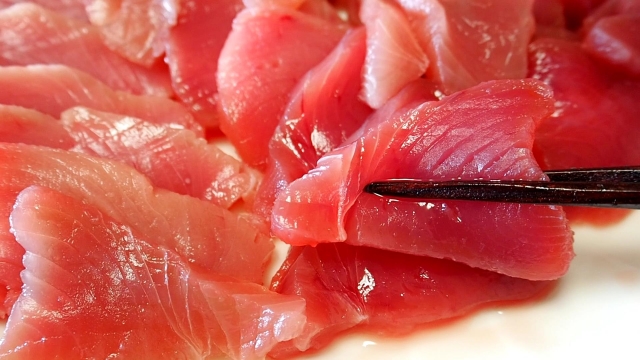
This one is a bit more local, underrated, and has a less interesting back story, but fun nonetheless! Occurring in May, the Hiroo Shopping District Association puts together this unique event every year. Hiroo is known for a few things: being a pretty posh and expensive area, and also full of foreigner expats.
Which means, despite the small size of the neighborhood, they have the money to (yet again, FOR FREE) give away fish, there is also a very large presence of foreign culture at this festival! From Brazilian drum circles, to American blues, including of course local Japanese groups, there are live performances all day, culminating in the filleting of a giant maguro, the king of Japanese fish!
Maguro is a type of tuna. THE type of tuna. You know that super red colored fish that is the standard in any sushi meal? Yes, that’s it. The neighborhood association drops unimaginable yen to buy a BIG one, cut it up, and dish it out to visitors and locals for free. A MUCH shorter wait time, and let’s face it, more delicious than sanma!
They also have a wide range of traditional Japanese summer festival style stalls and games, as well as a variety of drinks and cuisines from other cultures. Come for the performances, stay for the free tuna!
Don’t forget to bring your own Tupperware or plastic bag, as you can join the feeding frenzy and bring some of the leftovers home with you, as much as you feel comfortable digging into a giant fish!
Conclusion
These are two of the ones which I have frequented and can personally recommend, but they happen all over the country. Please check out what’s going on in your neck of the Japanese woods! And remember, fish is the chicken of the sea!
Photo Credits:
Top Photo: cheetahさん on PhotoAC
All other content (text) created by the original author and © 2022 MUSUBI by Borderlink
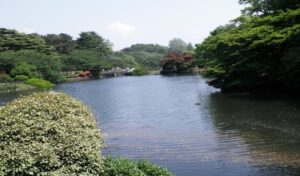 Shinjuku Gyoen Park is one the best escapes in Tokyo. I often refer to it as “Tokyo’s Central Park”. For many of us on a limited budget, Shinjuku Gyoen Park fits quite nicely as a modest place to seclude for a couple of hours after experiencing the hustle and bustle of Tokyo. Getting rid of stress by relaxing in a beautiful setting and spending time with friends and family in the outdoors cannot be beat! Best of all, access to Shinjuku Gyoen Park is easy!
Shinjuku Gyoen Park is one the best escapes in Tokyo. I often refer to it as “Tokyo’s Central Park”. For many of us on a limited budget, Shinjuku Gyoen Park fits quite nicely as a modest place to seclude for a couple of hours after experiencing the hustle and bustle of Tokyo. Getting rid of stress by relaxing in a beautiful setting and spending time with friends and family in the outdoors cannot be beat! Best of all, access to Shinjuku Gyoen Park is easy!
Access
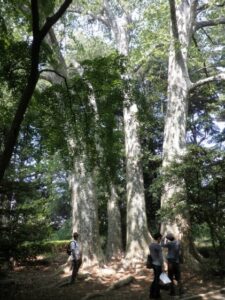 A quick look at the Japan Ministry of Environment webpage in English, Shinjuku Gyoen Park is from a 5-min to 15-min walk from five train lines. Want to try going by bus? No problem, there are three buses that will take you to the park’s Shinjuku Gate.
A quick look at the Japan Ministry of Environment webpage in English, Shinjuku Gyoen Park is from a 5-min to 15-min walk from five train lines. Want to try going by bus? No problem, there are three buses that will take you to the park’s Shinjuku Gate.
Bus No. 97 from Shinagawa-Shinjuku: destination Shinjuku ni-chome; Bus No. 86 from Ikebukuro-Shibuya: destination Shinjuku yon-chome: Bus No. 77 from Waseda-Shinjuku destination: Shinjuku san-chome.
Please refer to the webpage for the Sendagaya and Okido Gates. Once arriving at Shinjuku Gyoen Park, you are ready to explore.
What’s There?
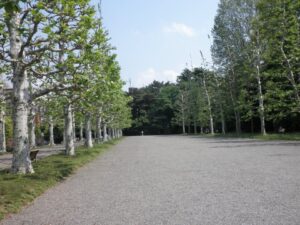 The major gardens are the English Landscape; French Formal; Japanese Traditional (with teahouse) and the “Mother and Child” Forest.
The major gardens are the English Landscape; French Formal; Japanese Traditional (with teahouse) and the “Mother and Child” Forest.
For everyone’s enjoyment, the park rules can be quite limiting on the types of activities you can do there. But it keeps the park nice and quiet compared to others in Tokyo (such as the more lively Yoyogi.)
However, there is still ample room to find a quiet spot to relax, especially during the Cherry Blossom viewing season in late March to early April. You won’t be disappointed!
When to Visit
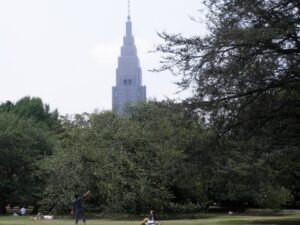 Shinjuku Gyoen is open Tues-Sun and closed Tues in the weeks in which Monday is a National Holiday.
Shinjuku Gyoen is open Tues-Sun and closed Tues in the weeks in which Monday is a National Holiday.
Admission for adults 500 yen (Group discount 400 yen). Refer to the webpage for updates. Convenient access by train or bus on a modest budget makes this a must-visit!
So, what are you waiting for? Grab your backpack, hat, and sunglasses and escape without leaving Tokyo. Don’t forget your mobile to snap those majestic photos of your escape. And hey, we can recommend a great place to eat after you visit!
Photo Credits:
All additional images taken and provided by Robert Henebry, used with permission
All other content (text) created by the original author and © 2022 MUSUBI by Borderlink
Ever wondered what Hell tastes like? As a self-diagnosed spice head and ramen lover, I wanted to find a restaurant that perfected these two things. After 5 minutes of rigorous searching using an ancient tool called “Youtube”, I came across a video of an excited American showcasing a ramen shop located in Kanda, Tokyo called “Kikanbo”.
So how can I try this spicy concoction?
Well, use a map of course! But, really there are actually two locations for this restaurant. The one in Kanda is accessible via the Yamanote and Keihin-Tohoku lines. The other location is in Ikebukuro which is accessible by the Yamonote, Saikyo, and many others that will just take forever to name.
What does Hell taste and look like exactly?
Pretty hot. Kikanbo uses a miso base for their soup and they allow the customers to make a choice of how much Kara (chili pepper) and Shibi (sansho pepper) they want in their ramen, which influences the intensity of the spice. I chose high for both because life is short, right?
The ramen itself will definitely is one to be remembered if you’re a ramen lover. The ramen has a bright lava-like glow to it and honestly just looks beautiful. So, great for Instagram pictures! Within the ramen, there are tender pieces of pork mixed in with bean sprouts, green onion and baby corn. Overall, the cost will be about 1200 yen.
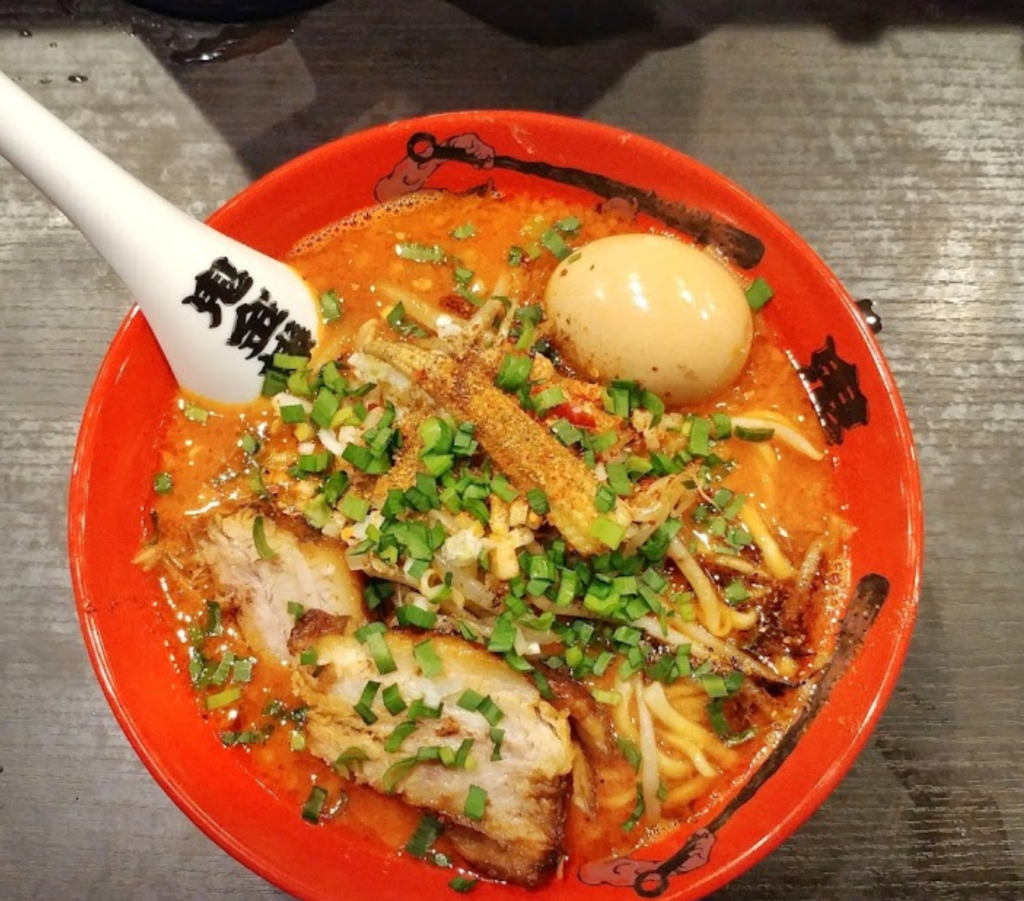
Photo provided by Patrick Noakes
How about the atmosphere though?
The shop itself is a great representation of what Hell might possibly be like. It included all things hellish like clubs on the walls, devil faces, and BTS playing on repeat. Just kidding! The music is a slow drum beat that will build up in a pace as you devour your ramen and almost makes you feel like you are going to be sacrificed to a god. The restaurant staff are nice though.
Conclusion
If you’re like me and are looking for that new spicy experience, then Kikanbo is really the spice hit that you need to try. Honestly, after years and years of mindlessly eating potatoes and boiled meats, it was nice to finally feel alive again. I will definitely be returning again to get that next spice hit soon. I advise you to do the same.
Photo Credits
All additional images taken and provided by Patrick Noakes, used with permission.
All other content (text) created by the original author and © 2022 MUSUBI by Borderlink
Once winter is over, and the weather becomes warmer, going to the sea in Japan is a very affordable and pleasant experience that you cannot miss. To the south of Kanagawa prefecture is the island of Enoshima. It is easy to get there, and you can enjoy a nice time even if you make it a one-day trip from Tokyo.
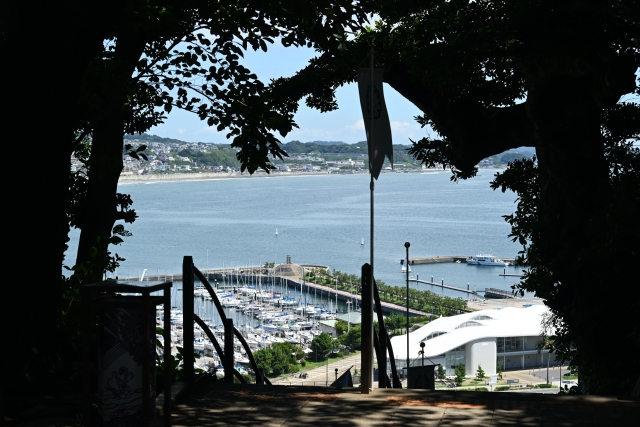
How to Get There
You can take the Odakyu line from Shinjuku station or the Shonan Shinjuku line that goes to Fujisawa station in 50 minutes. The Odakyu Enoshima line takes you from Fujisawa to Enoshima Island in 6 minutes. The ride from Shinjuku to Enoshima costs between 900 and 1500 yen depending on the transport you use.
Next, 3 things to try once you arrive at Enoshima:
1. Cross the Enoshima Benten Bridge
By walking from the station, you will enjoy the beautiful view of the sea and you will find the chance to see souvenir shops. Also, you can try and enjoy unique and tasty treats from the local cuisine. My favorite one is the Ice cream. There is nothing like the Enoshima ice cream!
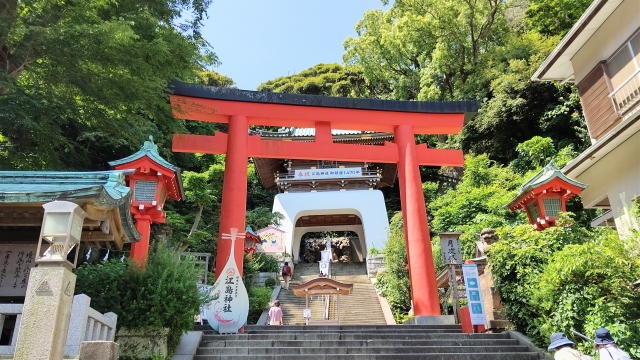
2. You can hike from the base to the top of the island
Along the way, you will find beautiful places where the view of the sea is fantastic. Depending on the season you will be able to enjoy gardens with different types of flowers. I suggest you take a little turtle food, so you can make some friends in the pond that is halfway.
3. The best part of the Island is up at the top
There you will find a fabulous garden, with a spectacular view. On a good day, you can see Mount Fuji, enjoy the breeze, and relax in the middle of the garden while reading or having a coffee. I must warn you that if you are eating snacks up there, you must be careful with the hawks. They are already used to people’s food so they have no qualms about swooping down to take your snacks.
I also recommend you to coordinate the schedule so you can enjoy the sunset from the top of the Island. It is an unforgettable experience. Just don’t forget to carry repellent because during the summer the mosquitoes also come up to enjoy the sunset.
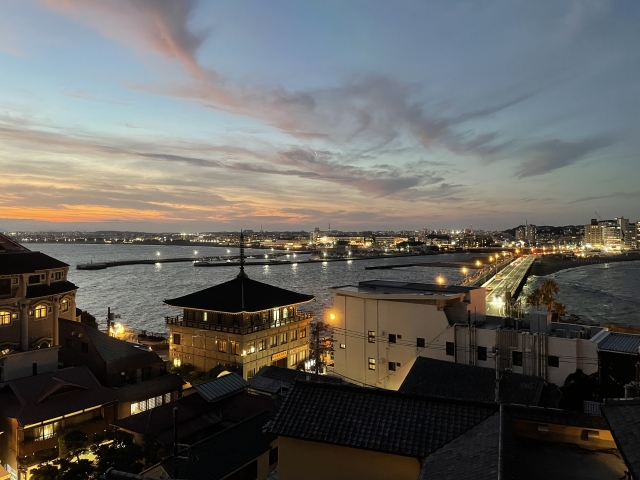
Conclusion
There are many other things you can do in Enoshima. There are spas at the base of the Island, there are good restaurants, and there is also an aquarium near the station. Anyway, enjoy the Island, it’s only an hour and 20 minutes from Tokyo, so don’t miss it!
Ready for your adventure on Enoshima or elsewhere in Japan? Get the ball rolling today- live and work in Japan as an ALT!
Photo Credits:
1- ジョン F. エンディさん on PhotoAC
All other content (text) created by the original author and © 2022 MUSUBI by Borderlink
…That We Need in English!
To start with, I think it is import to define what the difference between an idiom and an proverb are. Merriam-Webster defines idiom as “an expression in the usage of a language that is peculiar to itself either in having a meaning that cannot be derived from the conjoined meanings of its elements.”
This means simply that it is usually impossible to know or understand what an idiom is from looking at its individual words. For example idioms include “watch out, up in the air, or see red.” It also defines a proverb as “a brief popular epigram or maxim.” Or, expressions often used, in other words.
Anyway, here are 10 Japanese idioms and proverbs so amazing, I think we need to adopt them into English immediately!
見ぬが花 (Minu ga hana)
“Not seeing is a flower.”
What this basically means is that your imagination is infinity better than looking at something. This is one reason some people love books more than movies. No special effects can compare to the power of a person’s imagination. Sure, it might look cool on a screen, but I have to agree with the Japanese on this one.
虎穴に入らずんば虎子を得ず (Koketsu ni irazunba koji o ezu)
“If you do not enter a tiger’s den, you will not catch its cub.”
If you want to catch its cub, that is. The closest expression we have in English is probably “nothing ventured, nothing gained”. The English makes sense, but the Japanese expression is (in my opinion) much, much cooler. If you want to succeed, you have to grab the bull by its horns, strap in, and go for it. Wait, I guess English has quite a few idioms with the same meaning. Still, the Japanese one it pretty cool.
朝飯前 (あさめしまえ) (Asameshi mae)
“It can be done before breakfast.”
The task is so easy it can be accomplished after waking up but before eating breakfast. I believe that this is much simpler and easy to understand than the English equivalents “piece of cake” or “easy as pie.”
酒は本心を表す (Sake wa honshin wo arawasu)
“Sake shows one’s true feelings”
This one is quite simple to understand. A drunk person reveals who they really are on the inside. In English we really have no similar idiom or proverb, so I think this fills a very necessary gap. Some may dispute this proverb, but I think it sums up a poignant point-of-view.
三日坊主 (Mikka bouzu)
“A 3-day monk”
A person who inconsistently performs or often flakes out on doing their assigned tasks. This is the person who quits becoming a monk after only 3 days. This is an unreliable worker or student. In English, there is not really a concise way of describing this type of person. Which is why we need this Japanese idiom in English.
風の便り (Kaze no Tayori)
“A message carried on the wind”
Where did this rumor start? Was it “a little bird told me,” or did you get this information because it was a message on the wind? I like how the ambiguity of this phrase is summed up nicely. When we don’t know who/how/why info got out, is was delivered on the wind.
実る程頭の下がる稲穂かな (Minoru hodo Atama no Aagaru Inaho Kana)
“The mature rice plant lowers its head”
With old age comes wisdom and respect for others. It is interesting, the viewpoint of Japanese culture has towards the aged. It can be a useful expression in English to respect our elders because they (might) have this ability rather than an English “act your age” or “one foot in the grave.” It is about giving and receiving respect.
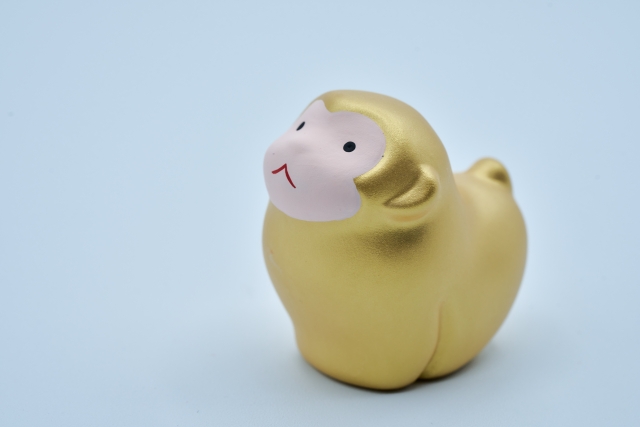
猿も木から落ちる (Sarumo kikara ochiru)
“Even monkeys fall from trees”
This one is actually pretty well known to those living in Japan. It is part of Japanese life. Basically, it means that no matter how good you are at something, mistakes happen. In English we say “to err is human” or “[expletive] happens”. But I think the imagery of the Japanese proverb is so much prettier.
目に入れても痛くない (Me ni irete mo itakunai)
“Even if you put it in my eye, it wouldn’t hurt”
HUH? So the idioms and proverbs are getting pretty obscure now, which is what makes them so fantastic! So, imagine a child or young animal so incredibly cute that it wouldn’t hurt having it shoved in your eye. OK, I’ll admit that logic left the room awhile ago, but it is soooooo cute. It reminds me of a word I heard a Filipino friend use, “gigil” meaning “so unbearably cute you have to pinch it”. Use this when something is so kawaii, that word no longer does it justice.
喉から手が出る (Nodo kara te ga deru)
“A hand coming out of one’s throat”
Ok, so bear with me while I unpack this idiom. When a person wants something so much, it is like a hand comes out of his/her throat to grab for it. That is so cool and funny! The imagery is fantastic, to desire something so much that an automatic response is for a grabby hand to make its way out of the mouth. This is why “Nodo kara te ga deru” is my number one.
So there you go, 10 phrases in Japanese that fill a void in English. If you have other idioms or proverbs from Japan, and you know where to find me, let me know. I always love learning new things and making my friends laugh with weirdly timed expressions. Enjoy impressing your Japanese friends and co-workers.
Now can you figure out the meaning of 猫に小判?
Photo Credits:
1 – SATOSHINPIさん on PhotoAC
All other content (text) created by the original author and © 2022 MUSUBI by Borderlink
Top photo: つくね_1st-さん on PhotoAC
Are you looking for ways to recharge your body after a long stressful week? Do you feel you need to rewind to rejuvenate in a peaceful, calming place? Do you enjoy soaking in natural hot springs? If you answered “Yes!” to all the above, this article offers you some quick tips.
If you are looking for a natural hot springs around Tokyo Tama area for a short relaxing break to rejuvenate your body, here are some of my top 3 picks.
Toki no Irodori Onsen (天然温泉 季乃彩)
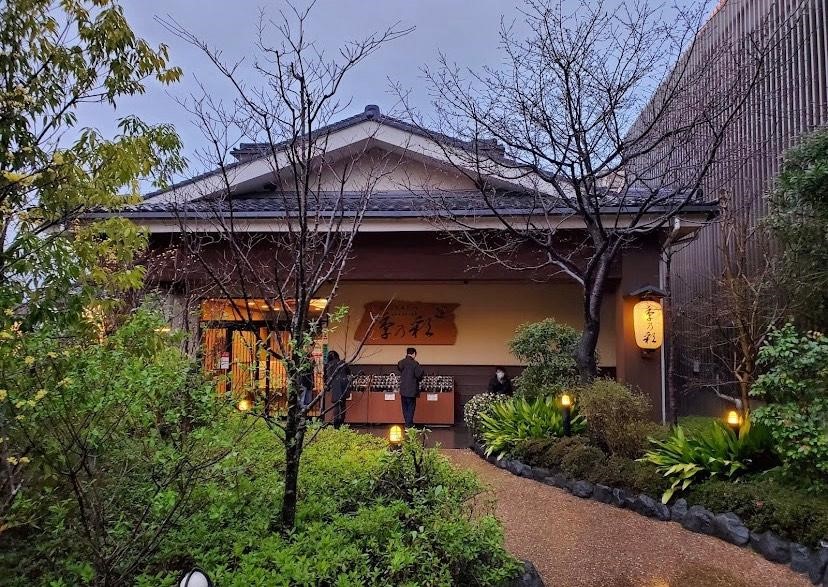
Toki no iro dori Onsen is a hidden relaxing realm in suburban Tokyo where you can enjoy peace, tranquility while rejuvenating your body and mind!
Talking about hot springs, do you know there is a natural hot spring and an artificial hot spring? How do you distinguish each of them? The “Natural hot spring display sign” or 天然温泉 issued by the Japan Hot Spring Association is one of the points to distinguish natural hot springs. The hot springs with this sign are natural hot springs.
If you are visiting Toki no Irodori Onsen for the first time, be sure to look for this sign at the main entrance. It is one of the natural hot springs in Tokyo with a depth of a 1,700m freely flows continuously. They offer a wide variety of facilities including a restaurant, black hot water, bedrock bath, hinoki (cypress) bath, lie down bath, carbonated spring bath, day’s special bath, akasuri, massage, playing area and rest area with ice cream and manga books. There is also a restaurant overlooking the Japanese garden, especially beautiful in spring or autumn.
Details:
9:00 – 25:00 (reception closes at midnight) Opens at 7am and public holidays
Prices:
Weekdays: Adults 800 yen | Below 15 y.o. 450 yen
Weekends: Adults 950 yen | Below 15 y.o. 650 yen. Towel set not included but available for hire
Access:
« Map »
Location:
6-13 Koyodai, Inagi-shi, Tokyo 206-0803
For the official homepage of Toki no iro dori Onsen, please click here (Japanese).
Sengawa Yukemuri-no-sato (仙川 湯けむりの里)
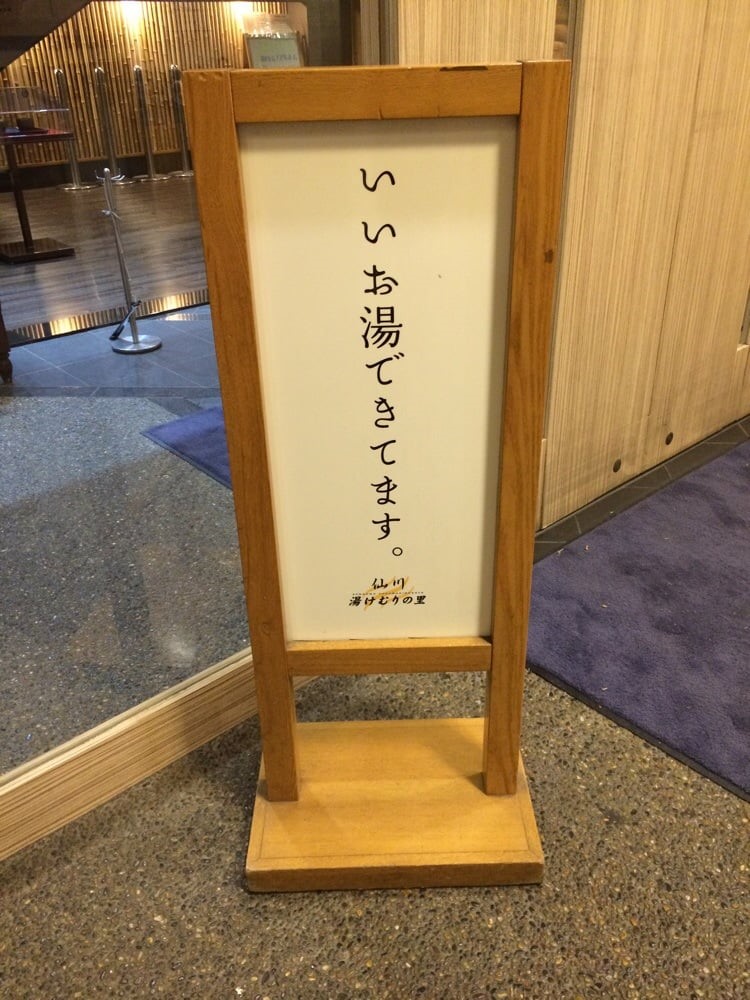
This onsen is conveniently accessible, only 20 minutes from Shinjuku on Keio line.
This is a large, modern Japanese onsen ideal after a long-tiring day! This relaxation facility have 12 different types of baths including a whirlpool bath, and rotenburo (outdoor bath) and bed rock baths. They use natural minerals like germanium and tourmaline which have special skin beautifying effects, strengthen your immune system, and enhances positive thinking and creativity.
The bedrock baths, with their healing effects are well known for improving your blood circulation and rejuvenating energy. It is no wonder that the facilities are well-loved by anyone from all ages and genders.
You can rent a bath towel and face towel at the reception counter.
Details:
Open: 10:00 AM – 2:00 AM Closes 10PM
Phone: 03-3309-4126
Prices:
Adults 750yen (weekdays) / 850yen (weekends/public holidays)
Children 400yen Children 450yen
Access:
Tokyo, Chofu, Wakabacho, 2 Chome−11−2
Hours:
Open: 10:00 AM – 2:00 AM Closes 10PM
Phone: 03-3309-4126
https://www.yukemurinosato.com/
Jindaji Yumorinosato Onsen (深大寺天然温泉 湯守の里)
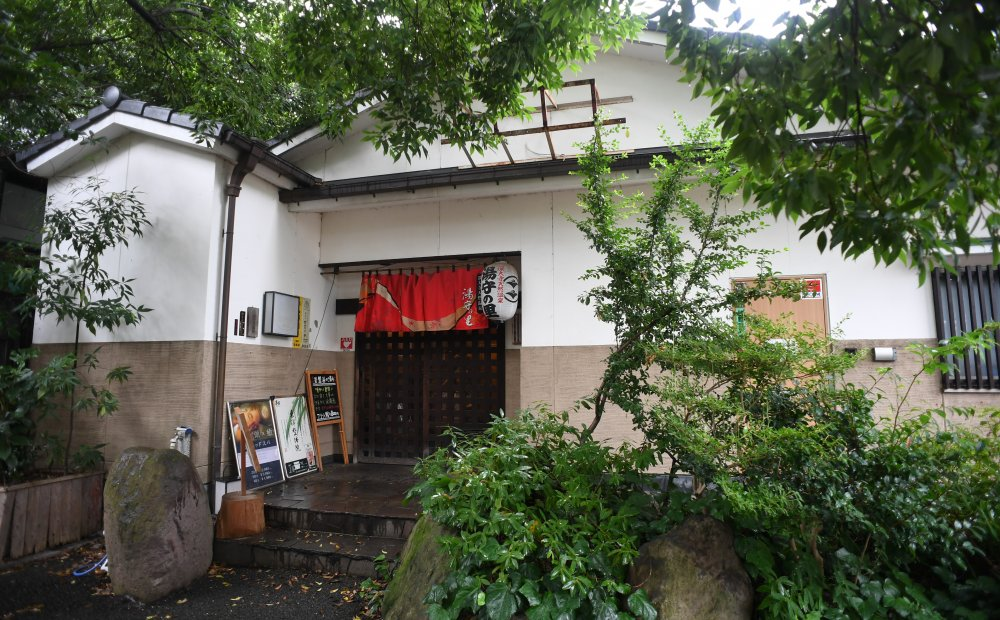
Another one of my favorites. Easily accessible offering a free shuttle bus service from Chofu station and Musashi-sakai station.
This is onsen is a real treat with special black bath water! Yumorinosato onsen is old and has a beautiful traditional atmosphere, you can smell the incense sticks reminding you of temples and shrines.
Try loosening up yourself at their variety of bedrock baths, saunas, and massages. Delicious Japanese foods await you at their restaurant. Don’t forget to taste the locals’ favorite, Jindaiji soba!
While you are there, please have a lovely stroll at the famous Jindaiji temple and its mesmerizing koi ponds. A charming huge rose garden is also a few meters away found in Jindaiji botanical park.
Details:
Opening Hours Every day 10:00~22:00
(Last admission at 21:30)
Prices:
Adults: 1000yen Weekend
Adults: 1,100 yen
Children: 600yen Children: 650 yen
Address:
2-12-2 Jindaiji Motomachi, Chofu-shi, Tokyo
Photo Credits
Top photo: つくね_1st-さん on PhotoAC
All additional images taken and provided by the original author, used with permission.
All other content (text) created by the original author and © 2022 MUSUBI by Borderlink
Top photo: NhatBanさん on PhotoAC
Japan is a consumer’s paradise and with multiple shopping complexes in all major cities, it’s not difficult to find ways to part with your money. When it comes to furnishing your house in Japan or buying clothes, we are all familiar with the staple chain stores that are present all around the country. But sometimes we don’t always want the same plastic storage bucket from the 100 yen store, or want clothes outside of the staples that many of the bigger brands in Japan.
After spending the last two years as a student, I started watching my pennies. I got into the habit of thrifting. It was budget friendly yet still allowed me to indulge in some retail therapy. Sustainability was also a motive, at the moment waste from clothing and fast fashion is a huge environmental issue. Giving life to new clothes and objects already in rotation just seemed like a logical thing to do. I still buy new things, but if I have the opportunity to thrift, I will swipe it.
When I switched back to ALT this year after working for a company that provided a uniform, I suddenly needed to have a whole new office casual wardrobe suitable for work and the different extremes of temperature in Japan. Where can we look beyond the high street for these kinds of essentials and fill our wardrobe for only a few thousand yen? Where can we find unique souvenirs that reflect the culture that we are immersed in without spending a fortune?
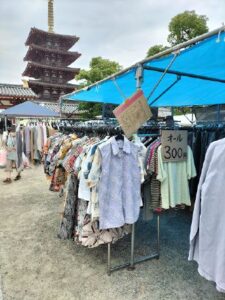
A thrift market in a historical setting. Photo by Kimberley North
If you’re looking for a way to incorporate a bit of history, culture, shopping and sustainability in Osaka, look no further than Shitennoji market. Shitennoji market is open on the 21st and 22nd of the month, in the grounds of Shitennoji Temple. While browsing the market, you can also enjoy the scenery in the expansive temple area.
There are multiple shrines, including one dedicated to hundreds of Jizo-san, as well as many tranquil ponds (one of which contained hundreds of sunbathing turtles). Shitennoji temple is one of the oldest temples in Japan, founded in around 5931 although it has been reconstructed at various points over the centuries due to fire damage.
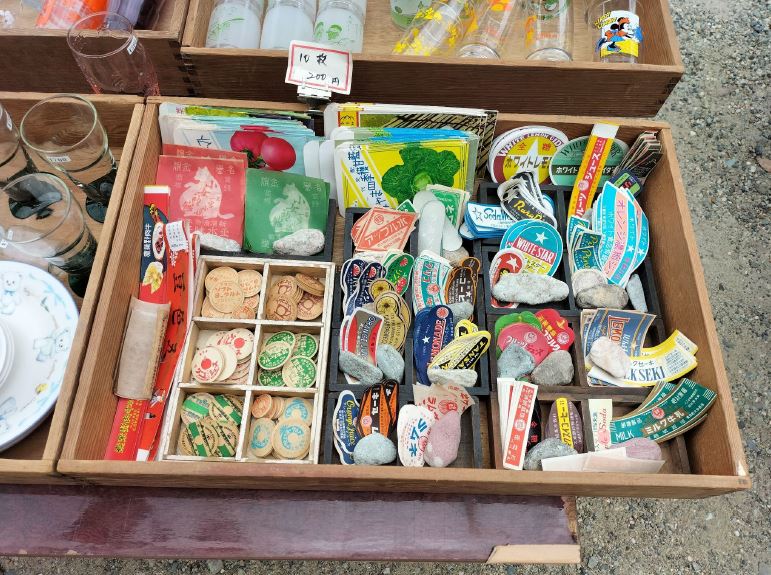
Vintage curiosities for sale. Photo by Kimberley North
The market is a joy to browse in itself. It’s famous for second hand kimono and yukata (cotton summer kimono), and is frequented by a lot of crafters who remake these garments. You can see people in bold and colourful outfits both shopping and manning the stalls, and there are many bargains to be found. I didn’t haggle while I was there, but I have heard that Osaka is one of the few cities where you can haggle with a vendor should you be bold enough to do so.
Regular and traditional clothes were everywhere, as well as stalls selling knickknacks and tchotchkes from Showa Era Japan. It’s also famous for antique furniture and tableware, so if you’re looking to snap up some unique plates with a history it may also be of interest to you. I even saw some antique Geisha wigs for sale.
I visited during summer, so was able to purchase some bargain Yukata and summer kimono for 500 yen, and even a pair of extremely comfortable and breezy parachute pants that were made from an old kimono. It’s definitely a great spot if you’re looking for a kimono for display or crafting, if that’s your thing. I’d recommend going early on the first day if you want to have the widest choice of items.
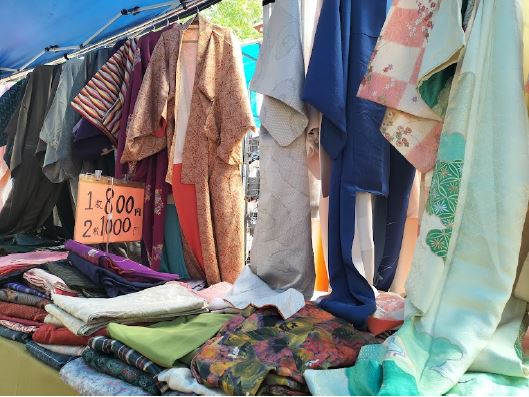
A selection of kimono and yukata. Photo by Kimberley North
If you’re looking for a bargain or just a great afternoon out, I highly recommend a few hours at Tennoji market. The fact that the area is filled with historically important temples just a 10 minute subway ride from the center of one of the biggest and livable cities in the world is really quite incredible. In these post-pandemic times many of us have felt the pinch, and what better way to help your pocket – and someone else’s pocket directly – than going to a market like this. It might just be the perfect place for you if you’re looking for that quirky item to give your home a bit of personality, or a lovely vintage gift rich with culture that you may want to send back to friends or family. These items are not only from Japan, but they have had a life here, and are sold by the people who have used and lived with them for even generations. That little slice of history isn’t something you can buy on the high street.
Shitennoji Temple information: The closest station is Shitennoji-mae Yuhigaoka on the Osaka metro Nagahori Tsurumi-ryoukuchi line, and is also about a ten minute walk from JR Tennoji station.
Photo Credits
Top photo: NhatBanさん on PhotoAC
All additional images taken and provided by Kimberley North, used with permission.
All other content (text) created by the original author and © 2022 MUSUBI by Borderlink
Top Photo: TomiFactoryさん on PhotoAC
Are you in Tokyo and hungry? Do you want to try different delicious dishes without spending a lot of money? Well then have I got a place for you to try!
Japan is well-known for its beautiful and rich culture, which draws many visitors from all over the world. If you are visiting Japan, you should not miss out on visiting its capital city, Tokyo. Tokyo has many attractions, shopping districts, entertainment options, and everyone’s favorite thing of all- food. However, Tokyo is one of Asia’s most expensive cities to live in, likely leading you to believe that everything here is expensive.
Thankfully, this is not the case. When I hang out with my friends, our main issue is always what to eat. I enjoy food, but do not want to spend a lot of money. After much searching, we discovered something else Japan does very well: buffets, or as they are also known, Vikings! Here is one of my favorites:
Tokyo Statuon Buffet: Chisozanmai
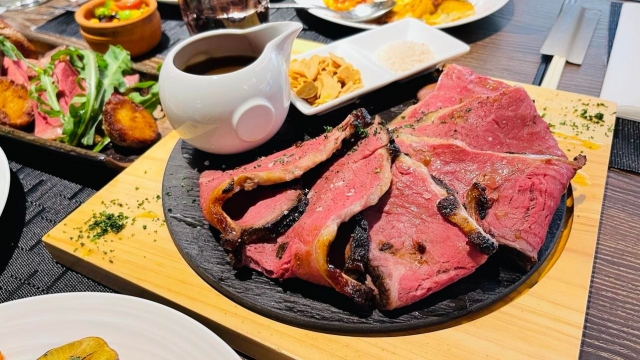
Just a four-minute walk from the Tokyo Station and you will find this elegant and cozy ambiance of an all-you-can-eat buffet restaurant offering about 60 kinds of dishes and free drinks. The lunch time starts at 11:00 and ends at 16:00. For the very reasonable price of 2,900 yen for adults, 1,800 yen for elementary students, 700 yen for lower school levels. Children 2 and under eat for free! However, for the dinner time that starts from 16:00 and ends at 23:00. The price for adults changes from 2,900 yen to 3,600. Still, for all you can fill your plate with (as many times as you want) + drinks, it’s a good deal!
Here are some of the dishes they offer:
Sushi
Tempura
Grilled Fish
Sukiyaki
Simmered Sweet Potato
Japanese Potato and meat stew
Roast Beef
Beef Stew
Crab Fried Rice
Shrimp with Egg Chili Sauce
Pizza
Fresh Salads and Fruits
Cheese Cake
Strawberry Shortcake
Almond Jelly with Strawberry Sauce
And there are many more. Do you like crabs? This is your lucky day, because this buffet restaurant also serves crabs! All-you-can-eat snow crab legs are available for an additional 3,300 yen.
Conclusion
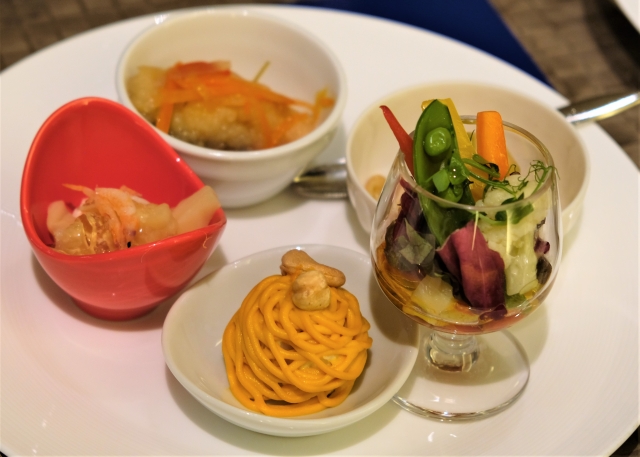
If you want to eat a wide variety of food without spending a lot, then try buffet restaurants. You don’t need to go to an expensive restaurant just to eat good food. The offerings of Chisozanmai are worth every yen. Try it- I guarantee you’ll like it!
Access:
TOKYO STATION BUFFET, 大丸東京店 12F 1 Chome-9-1 Marunouchi, Chiyoda City, Tokyo 100-6701
Photo Credits:
Top Photo: TomiFactoryさん on PhotoAC
1- TomiFactoryさん on PhotoAC
All other content (text) created by the original author and © 2022 MUSUBI by Borderlink
